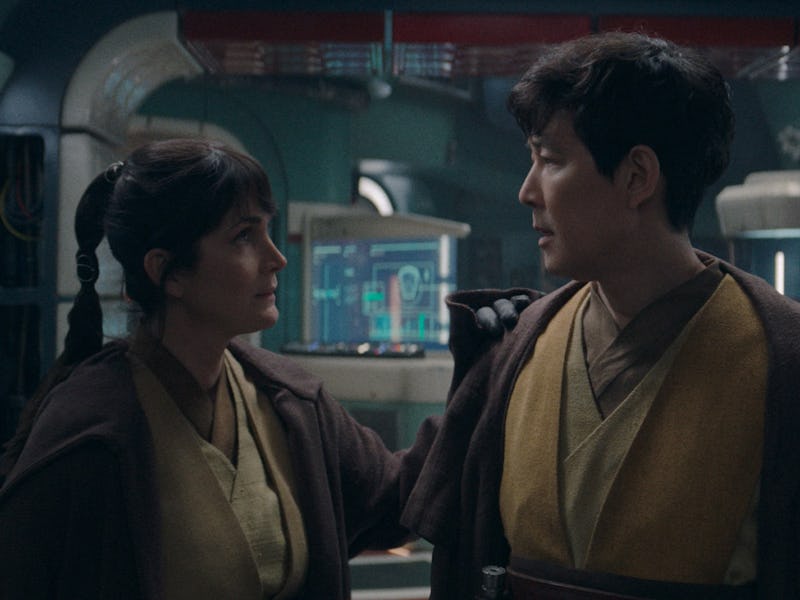The Acolyte is Not Afraid to Experiment — And It’s Starting to Backfire
Did we really need another flashback episode?

The Acolyte Episode 7 is, like the Star Wars series' third installment, a flashback episode. It revisits the events of "Destiny" and shows them, this time, from the perspectives of Sol (Lee Jung-jae), Torbin (Dean-Charles Chapman), and Indara (Carrie-Anne Moss). The episode (titled "Choice") reveals, among other things, that it was Sol who — in a moment of misguided panic — stabbed one of Osha (Amandla Stenberg) and Mae's mothers, Aniseya (Jodie Turner-Smith), and that he subsequently let Mae fall from her broken Brendok bridge in order to save Osha.
The episode arguably does a better job of communicating the complete tragedy of Osha and Mae's origin story than "Destiny." But does it reveal or do enough to warrant another 44 minute-long trip to the past? It's hard to say that it does, especially considering that a not-insignificant portion of its runtime is spent on moments that viewers already saw in "Destiny," which ranks alongside "Choice" as the longest episodes of The Acolyte to date.
There is, indeed, something fundamentally off about "Choice," which grinds the momentum of The Acolyte's first season to a halt for the second time and does so for reasons that seem both misguided and deeply flawed.
Sol’s attempts to exercise some Jedi control lead to destruction in “Choice.”
What is actually revealed in The Acolyte's penultimate episode? In addition to Sol's involvement in Aniseya's demise and Mae's near-demise, we learn that he and his fellow Jedi were sent to Brendok to investigate a possible vergence (i.e., a rare concentration of powerful Force energy) and that Mae and Osha were likely created by Aniseya using said vergence. We also learn that Sol felt driven to protect Mae and Osha because he wrongly thought they were being mistreated, that Torbin chose to help Sol infiltrate Aniseya's mountain fortress because he, uh, really wanted to go back to Coruscant, and that it was Indara who conceived the cover-up of what really happened.
Aside from how thin both Sol and Torbin's motivations seem in "Choice," the episode's twists were telegraphed so obviously by The Acolyte's previous episodes that they don't pack nearly as much of a punch as they would have otherwise. Even the revelation that Mae and Osha were likely created using energy from the Force had already been guessed by plenty of Star Wars fans. The installment's most important pieces of information don't, therefore, justify its 40-plus minute runtime and could have — and likely should have — been communicated in a far more concise manner than they are. The fact that they weren't only makes "Choice" feel more like a classic instance of a flashback episode doubling as a way for a show to pad out its season's length.
The predictability of what happens in the episode's final act might not have mattered had it not felt like "Choice" was designed with shock value in mind. The events of the episode are important solely because of what they mean to Osha, but she's largely absent from "Choice." The Acolyte Episode 6, in fact, sets up "Choice" by having Sol inform Mae that he's going to tell her the truth of what happened on Brendok, despite the fact that nothing that's shown throughout the episode will alter her opinion of the Jedi in any way. It's still only Osha who the truth will matter to, and yet "Choice" feels like it was structured and placed within The Acolyte's season solely with the show's viewers in mind — rather than its characters.
In “Choice,” The Acolyte revisits the defining moment of Osha and Mae’s lives.
Structurally speaking, The Acolyte Season 1 has been extremely odd. Its present-day episodes have largely felt trimmed within an inch of their life. It has, nonetheless, still found the time for two flashback episodes (about the same incident, mind you) that aren’t nearly as lean as the season's other installments. The show's pace has, consequently, felt inconsistent throughout its first seven episodes.
That feeling has only been exacerbated by The Acolyte’s habit of slowing things down and shifting its focus just when its momentum is starting to build. It did that when it chose to split "Day" and "Night" into two episodes released a week apart, and it's done it again by turning its eye back to the past just when its most compelling storyline — Qimir's (Manny Jacinto) budding mentorship of Osha — is beginning to develop. Altogether, these decisions have made The Acolyte feel like a show dictated by its format, as opposed to one that has formed its episodes around its characters' stories and needs.